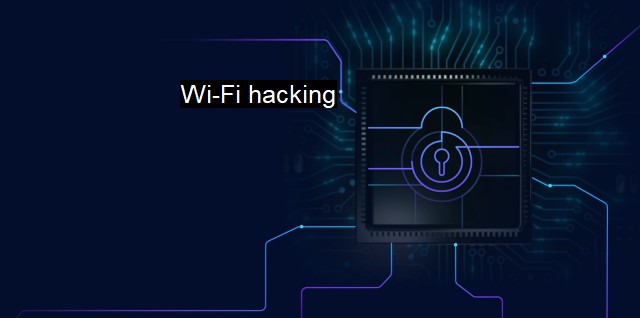What is Wi-Fi hacking?
Securing Your Wireless Network: Understanding Wi-Fi Hacking Techniques and Safeguarding Your Devices
Wi-Fi hacking is a method used by cybercriminals to gain unauthorized access to wireless networks via a variety of techniques exploiting linked devices. With cyber threats becoming ubiquitous in nature, understanding the term 'Wi-Fi hacking,' especially is crucial.Wi-Fi hacking refers to various routine activities and advanced techniques that a hacker can employ to manipulate the standard network protocols and security protections with the sole aim to exploit system vulnerabilities. These breaches allow unauthorized individuals remote access to your network's data and often affect the network speed, it's the overall performance and can even block the access of authentic users. Thus, it leads to potential cybersecurity threats like data theft, defamation, snooping, disturbance in privacy, and much more.
Primarily, most Wi-Fi hackers focus on infiltrating two types of Wi-Fi networks: WEP (Wired Equivalent Privacy) and WPA or WPA2 (Wi-Fi Protected Access). WEP is an older, vastly insecure wireless network protocol, which makes it a soft target for hackers worldwide. With vulnerabilities easy to exploit, WEP has now been replaced by the WPA and more secure WPA2 networks as the primary network protocol for Wi-Fi. Meanwhile, WPA2, despite being relatively more secure, is still not entirely immune to Wi-Fi hacking. Many hacking tools capable of cracking WPA keys are readily available on the black market, adding to the security issues the current Internet user continues to face.
Cybercriminals use a range of advanced Wi-Fi hacking tactics to compromise networks. These techniques mainly include eavesdropping, evil twin attack, denial-of-service attack, and man-in-the-middle attack. In eavesdropping, hackers capture and analyze packets of information being transmitted over networks. In an evil twin attack, a fraudulent Wi-Fi access point is set up mimicking a legitimate one, causing users to unintentionally connect to it. Denial-of-service attack involves flooding networks with data to overwhelm them and cause shut down. Man-in-the-middle attack is when hackers intercept and possibly alter communication between two parties without them knowing.
Thus, protecting Wi-Fi networks from hackers by taking necessary measures has become the need of the hour. To ensure cybersecurity, using antivirus software comes in handy as it provides real-time protection against many potential threats like viruses, malware, ransomware, and other advanced threats. Besides, software updates are vital to patch vulnerabilities that can be exploited by cybercriminals.
Creating a secure password for the network including diverse characters, setting up a firewall to block suspicious looking incoming connections, maintaining up-to-date router firmware, and strengthening wireless network encryption can do wonders in securing your Wi-Fi networks from potential hacks.
Also, limiting the range of the Wi-Fi network, disconnecting from the network when not used, and enabling network encryption are alternatives to increase the security of Wi-Fi networks. users are encouraged to verify the websites and emails they interact with and avoid clicking on suspicious links, or downloading unknown attachments and applications from unreliable sources.
Wi-Fi hacking is an enormously pervasive issue capable of bringing about severe damage to the personal and professional lives of individuals. Recognizing its potential damages and taking expedient precautionary measures against such breaches is Essential. As technologies evolve, so will cyber threats. Therefore, strongly emphasizing the importance of consistent vigilance, proactive defense mechanisms, awareness about the increasing myriad of cyber threats, and a robust, recurring cycle of optimization of cybersecurity practices to handle the evolving algorithm of cyber threats.

Wi-Fi hacking FAQs
What is Wi-Fi hacking?
Wi-Fi hacking refers to the process of gaining unauthorized access to a wireless network, either for the purpose of stealing sensitive information or creating havoc. It involves using various techniques to exploit vulnerabilities in the Wi-Fi network and gain access to its data.How can I protect my Wi-Fi network from hacking?
To protect your Wi-Fi network from hacking, you should follow some best practices, such as changing your router's default login credentials, enabling WPA2 encryption, updating your router's firmware regularly, and disabling remote management. You can also use antivirus software that includes a firewall and a Wi-Fi scanner to monitor your network for any suspicious activity.Is Wi-Fi hacking illegal?
Yes, Wi-Fi hacking is illegal if you don't have the owner's permission to access their network. It is considered a cybercrime under most legal systems, and offenders can face penalties ranging from fines to imprisonment. However, there are ethical hacking or penetration testing services that work with the owner's consent to identify vulnerabilities and secure the network.Can antivirus software protect me from Wi-Fi hacking?
Antivirus software can protect you from Wi-Fi hacking to some extent by detecting and preventing malware that can exploit vulnerabilities in your Wi-Fi network. However, it cannot prevent someone from accessing your network if they have the right credentials or use advanced hacking techniques. You should still follow best practices to secure your Wi-Fi network and avoid becoming a victim of Wi-Fi hacking.| | A | | | B | | | C | | | D | | | E | | | F | | | G | | | H | | | I | | | J | | | K | | | L | | | M | |
| | N | | | O | | | P | | | Q | | | R | | | S | | | T | | | U | | | V | | | W | | | X | | | Y | | | Z | |
| | 1 | | | 2 | | | 3 | | | 4 | | | 7 | | | 8 | | |||||||